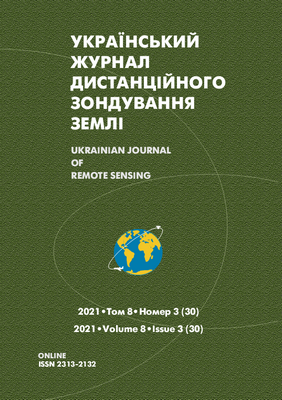Data combination method in Remote Sensing tasks in case of conflicting information sources
DOI:
https://doi.org/10.36023/ujrs.2021.8.3.201Keywords:
evidence theory, Jaccard coefficient, basic probability assignment, combination rules, conflicting evidenceAbstract
Nowadays technologies of UAV-based Remote Sensing are used in different areas, such as: ecological monitoring, agriculture tasks, exploring for minerals, oil and gas, forest monitoring and warfare. Drones provide information more rapidly than piloted aerial vehicles and give images of a very high resolution, sufficiently low cost and high precision.
Let’s note, that processing of conflicting information is the most important task in remote sensing. Dempster’s rule of data combination is widely used in solution of different remote sensing tasks, because it can processes incomplete and vague information. However, Dempster’s rule has some disadvantage, it can not deal with highly conflicted data. This rule of data combination yields wrong results, when bodies of evidence highly conflict with each other. That’s why it was proposed a data combination method in UAV-based Remote Sensing. This method has several important advantages: simple calculation and high accuracy.
In this paper data combination method based on application of Jaccard coefficient and Dempster’s rule of combination is proposed. The described method can deal with conflicting sources of information. This data combination method based on application of evidence theory and Jaccard coefficient takes into consideration the associative relationship of the evidences and can efficiently handle highly conflicting sources of data (spectral bands).
The frequency approach to determine basic probability assignment and formula to determine Jaccard coefficient are described in this paper too. Jaccard coefficient is defined as the size of the intersection divided by the size of the union of the sample sets. Jaccard coefficient measures similarity between finite sets. Some numerical examples of calculation of Jaccard coefficient and basic probability assignments are considered in this work too.
This data combination method based on application of Jaccard coefficient and Dempster’s rule of combination can be applied in exploring for minerals, different agricultural, practical and ecological tasks.
References
Alpert, S. (2020). A new approach to applying the discount rule in hyperspectral satellite image classification. Management of Development of Complex Systems, 43. 76–82. doi.org10.32347/2412-9933.2020.43.76-82.
Alpert, М. І., Alpert, S .І. (2020). New methods to determine basic probability assignment and data fusion in Hyperspectral Image Classification. Proceedings of the XIX-th International Conference on Geoinformatics. Theoretical and Applied Aspects. 1–5.
Alpert. М. І., Alpert, S. І. (2021). A new approach to accuracy assessment of land-cover classification in UAV-based Remote Sensing. Proceedings of the XXth International Conference on Geoinformatics Theoretical and Applied Aspects. 1–5.
Jousselme, Anne-Laure. Grenier, Dominic, Bosse,. Eloi. (2001). A new distance between two bodies of evidence. Information Fusion, 2. 91–101.
Gong, P. (1996). Integrated Analysis of Spatial Data from Multiple Sources: Using Evidential Reasoning and Artificial Neural Network Techniques for Geological Mapping. Photogrammetric Engineering and Remote Sensing, 62 (5). 513–523.
Kosub S. (2019). A note on the triangle inequality for the Jaccard distance. Pattern Recognition Letters. 120. 36–38.
Lein, J. K. (2003). Applying evidential reasoning methods to agricultural land cover classification. Int. Journal of Remote Sensing, 24 (21). 4161–4180.
McKnight, V. (2015). Drone technology and the Fourth Amendment: aerial surveillance precedent and Kyllo do not account for current technology and privacy concerns. California Western Law Review, 51. 263.
Mertikasm P., Zervakism M. E. (2001). Exemplifying the Theory of Evidence in Remote Sensing Image Classification, Int. Journal of Remote Sensing. 22 (6). 1081–1095.
Popov, M., Alpert, S., Podorvan, V., Topolnytskyi , M., Mieshkov, S. (2015). Method of Hyperspectral Satellite Image Classification under Contaminated Training Samples Based on Dempster-Shafer’s Paradigm. Central European Researchers Journal. 1 (1). 86–97.
Popov, M .A., Alpert, S .І., Podorvan, V. N. (2017). Satellite image classification method using the Dempster-Shafer approach. Izvestiya, atmospheric and oceanic. Physics, 53 (9). 1112–1122. doi: 10.1134/s0001433817090250
Downloads
Published
How to Cite
Issue
Section
License
Licensing conditions: the authors retain their copyrights and grant the journal the right of first publication of a work, simultaneously licensed in accordance with the Creative Commons Attribution License International CC-BY, which allows you to share the work with proof of authorship of the work and initial publication in this journal.
The authors, directing the manuscript to the editorial office of the Ukrainian Journal of Remote Sensing of the Earth, agree that the editorial board transfers the rights to protection and use of the manuscript (material submitted to the journal editorial board, including such protected copyright objects as photographs of the author, drawings, charts, tables, etc.), including reproduction in print and on the Internet; for distribution; to translate the manuscript into any languages; export and import of copies of the journal with the article of the authors for the purpose of distribution, informing the public. The above rights are transferred by the authors to the editors, without limitation of their validity, and in the territory of all countries of the world without limitation, including in Ukraine.
The authors guarantee that they have exclusive rights to use the submitted material. The editors are not liable to third parties for breach of data by the authors of the guarantees. The authors retain the right to use the published material, its fragments and parts for personal, including scientific and educational purposes. The rights to the manuscript are considered to be transferred by the authors of the editorial board from the moment of the publication of the issue of the journal in which it is published. Reprinting of materials published in the journal by other individuals and legal entities is possible only with the consent of the publisher, with the obligatory indication of the issue of the journal in which the material was published.
